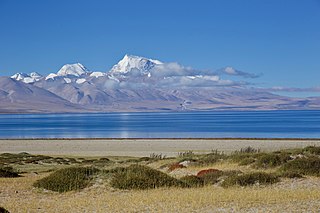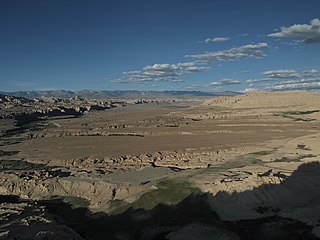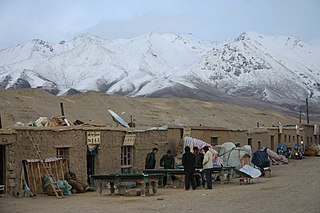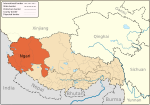
Ngari Prefecture is a prefecture of China's Tibet Autonomous Region. Its capital is Gar County. Its administrative centre and largest settlement is Shiquanhe.

Shiquanhe, known in Tibetan as Sênggêkanbab or Sênggêzangbo, is the main town and administrative seat of Ngari Prefecture, Tibet Autonomous Region, China. Shiquanhe is located on the bank of Sênggê Zangbo, the main headwater of the Indus River, close to its confluence with the Gartang River.
Gyanema or Gya'nyima (Tibetan: རྒྱ་ཉི་མ, Wylie: rgya nyi ma, THL: gya nyi ma) is a large plain at the border between the Zanda County and Burang County in western Tibet, which was once used for an annual market of Indo-Tibetan trade. The border has been sealed and the market shut down since the Sino-Indian War of 1962. At the present time, there is only a small settlement at the western edge of the plain called Xilanta, where China operates a military outpost.

Dragsum Tsho (Tibetan: བྲག་གསུམ་མཚོ་, Wylie: brag gsum mtsho, THL: Draksum Tso, Pagsum Co, literally meaning “three rocks” in Tibetan, is a lake covering 28 square kilometres in Gongbo'gyamda County, Nyingchi of the Tibet Autonomous Region, China, approximately 300 km east of Lhasa. At 3,700 metres over sea level it is about 18 km long and has an average width of approximately 1.5 km. The deepest point of the green lake measures 120 metres. The lake is also known as Gongga Lake.
Langdarma was most likely the last Tibetan Emperor who most likely reigned from 838 to 841 CE. Early sources call him Tri Darma "King Dharma". His domain extended beyond Tibet to include Dunhuang and neighbouring Chinese regions.
This is a list of topics related to Tibet.

Coqên County is a county in the Ngari Prefecture, in the west of the Tibet Autonomous Region of China. It is the located in the southeast of Ngari Prefecture.

Gar County, also spelled as Gaer County, is a district (county) in the Ngari Prefecture of the western Tibet Autonomous Region of China. The main town is Shiquanhe, once known as the city of "Gar" and often known as "Ali" in English.

Zanda County or Tsamda County is a county in the Ngari Prefecture to the extreme west of the Tibet Autonomous Region of China. Its seat of power is at Tholing, the former capital of the Guge kingdom.

Burang, known as Purang in Tibetan, is a town which serves as the administrative center of Burang County, Ngari Prefecture of the Tibet Autonomous Region (TAR), China. The town lies at an altitude of 3,900m in the valley of the Karnali River. As of 2010, the town had a population of 6,047. To the south are Gurla Mandhata and the Abi Gamin ranges. Lake Manasarovar and Mount Kailash are to the north. This region is the mythological and actual river nexus of the Himalaya with sources of the Indus, Ganges and Yarlung Tsangpo/Brahmaputra all within 110 kilometres (70 mi) of Burang.

Minsar or Moincêr is a village and the centre of a township in the Ngari Prefecture of the Tibet region of China. It is legally an enclave of India in Tibet, occupied by China since 1959.

The following outline is provided as an overview of and topical guide to Tibet:

Sengge Zangbo, Sengge Khabab or Shiquan He is a headwater of the Indus River in the Ngari Prefecture in Tibet Autonomous Region, China. About 300 km from its sources, in the mountain springs north of the Manasarovar lake, the river merges with Gar Tsangpo near the village of Tashigang to form the Indus River. The Tibetans continue to regard the combined river as Sênggê Zangbo as it flows into Ladakh.

Jiesa Lake or Gyesar Tso is a lake in Coqên County in the Ngari Prefecture of the Tibet Autonomous Region of China. It is located southwest of Coqên Town. Fed by 27 small streams, it is 32.1 km long and 7.2 km wide and has an area of 146.4 square km.

Dawa, or Dawacuo, is a lake in Coqên County in the Ngari Prefecture of the Tibet Autonomous Region of China. It is located several kilometres northwest of Coqên Town. Daxiong is a village located beyond its northeastern bank. The name of lake means "Moon Lake" in Tibetan language.

Bangda Lake, formerly called Yeshil Kul, is a glacial lake in Ngari Prefecture in the northwest of the Tibet Autonomous Region of China. It lies south of the western Kunlun Mountains, only a few kilometres to the southeast of Guozha Lake.
The Spanggur Tso, also called Maindong Tso, Mendong Tso, is a saltwater lake in Rutog County in the Tibet Autonomous Region of China, close to the border with Ladakh. To the west of the lake lies the Spanggur Gap, and to the north is the Pangong Tso. The lake is at an elevation of 4305 meters, and has an area of 61.6 square kilometres. The lake's average annual temperature is around -4 to -2 ℃, and the annual precipitation is 50 to 75 mm. The western portion of the lake is claimed by India.
Noh, also called Üchang or Wujang (Tibetan: དབུས་བྱང, Wylie: dbus byang, THL: wü jang) is a village in the Rutog County, Ngari Prefecture of the Tibet region of China. It is located on the northern bank of the eastern Pangong Lake, watered by the Doma River (Tsanger-schar). The village is now part of the Domar Township.
Zhaxigang Township is a township-level administrative unit under the jurisdiction of Gar County, Ngari Prefecture, Tibet Autonomous Region. It has jurisdiction over Zhaxigang Village, Luma Village and Dianjiao Village.
Tashigang, also spelt Trashigang and Zhaxigang, is a place name in the Tibetan language meaning "good fortune ridge". It may refer to:















